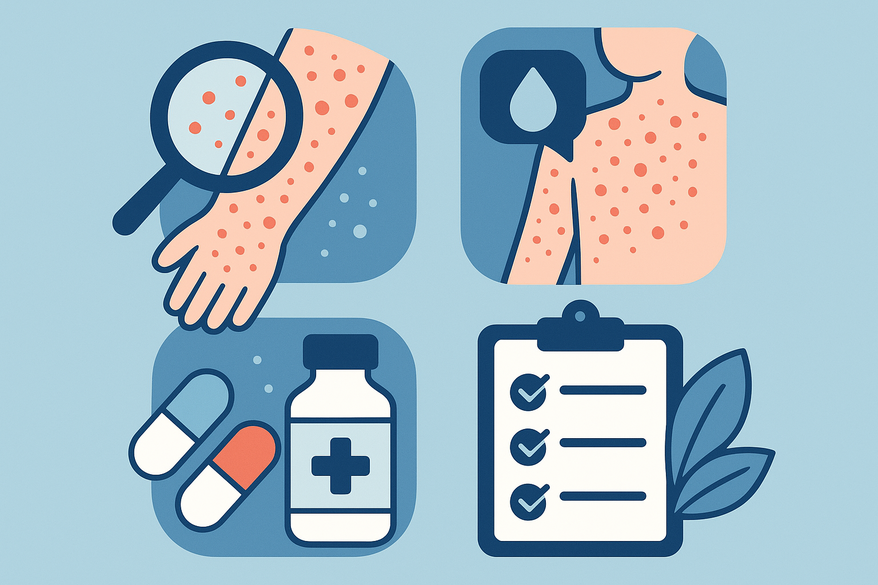Identifying and Managing Drug-Induced Rash Symptoms
Learn to identify drug-induced rash symptoms like itching and blistering, explore treatment options, and discover prevention strategies for medication rashes.

Estimated reading time: 12 minutes
Key Takeaways
- Early recognition of drug-induced rashes—from mild redness to Stevens-Johnson syndrome—is vital to prevent serious complications.
- Symptom checklist includes timing of onset, appearance of maculopapular eruptions, blistering, itching, and mucosal involvement.
- High-risk medications include antibiotics, anticonvulsants, NSAIDs, and certain antihypertensives.
- Diagnostic approach relies on detailed history, physical exam, drug withdrawal challenge, labs, and biopsy when needed.
- Treatment options range from topical steroids and antihistamines to emergency care for severe reactions.
- Prevention strategies emphasize allergy history review, one-drug-at-a-time introductions, patient education, and patch testing.
Table of Contents
- Introduction to Drug-Induced Rash Symptoms
- Overview of Drug-Induced Rashes
- Common Drug-Induced Rash Symptoms
- Medications That Can Cause Drug-Induced Rashes
- How to Identify & Differentiate Drug-Induced Rash Symptoms
- Diagnosis & Medical Testing for Drug-Induced Rashes
- Management & Treatment Options for Drug-Induced Rashes
- Prevention Strategies for Drug-Induced Rashes
- Conclusion
- Additional Resources & References
- FAQ
Introduction to Drug-Induced Rash Symptoms
Drug-induced rash symptoms manifest as skin changes—redness, bumps, or blisters—triggered by prescription or over-the-counter medications. They can be as mild as a pink maculopapular rash or as severe as Stevens-Johnson syndrome. Early detection reduces hospital stays and prevents life-threatening complications.
Overview of Drug-Induced Rashes
A drug-induced rash results from:
- Allergic hypersensitivity (immune-mediated)
- Direct cytotoxicity to skin cells
- Photosensitivity under UV exposure
- Drug–drug or drug–sunlight interactions
Key Points:
- Timeline: Days to weeks after starting a new medication
- Presentation: Often begins on the trunk, spreading symmetrically
- Severity: From mild maculopapular eruptions to widespread blistering
Common Drug-Induced Rash Symptoms
Visual cues and patient complaints help distinguish drug reactions from other dermatoses:
- Redness or Discoloration
- Bright pink to red patches on fair skin
- Purple or dark brown discoloration on darker tones
- Bumps or Flat Maculopapular Rash
- Raised papules mixed with flat macules, often itchy
- Widespread exanthematous rash
- Itching (Pruritus)
- Persistent urge to scratch, often worse at night
- Blistering or Peeling
- Fluid-filled vesicles or bullae
- Peeling resembling severe sunburn
- Swelling and Pain
- Localized edema and tenderness
- Hives (Urticaria)
- Raised, itchy welts that migrate and resolve within hours
Severe presentations like target lesions and mucosal involvement are hallmarks of Stevens-Johnson syndrome. Patient factors—age, immune status, co-morbidities—influence severity.
Medications That Can Cause Drug-Induced Rashes
Notorious culprits include:
- Antibiotics (penicillins, sulfonamides)
- Anticonvulsants (phenytoin, carbamazepine, lamotrigine)
- NSAIDs (ibuprofen, naproxen)
- Antihypertensives (ACE inhibitors, beta-blockers in rare cases)
Most reactions are mild exanthematous rashes, but rare severe forms require immediate intervention.
How to Identify & Differentiate Drug-Induced Rash Symptoms
- Timing of Onset: 4–21 days after drug initiation (urticaria may occur within hours)
- Distribution & Pattern: Starts on the trunk, spreads symmetrically; photo-exposed patterns for photosensitive drugs
- Associated Signs: Pruritus, low-grade fever, malaise versus high fever in infections or chronic target lesions in autoimmune conditions
- Red Flags: Angioedema, mucosal lesions, rapid blistering or peeling, difficulty breathing
- Patient Tips:
- Keep a medication diary—document start dates and doses
- Take daily photos to track rash progress pictures
- Follow our tips on taking clear rash photos
- Explore the best skin tracking tools
- Report early signs to a healthcare provider
Diagnosis & Medical Testing for Drug-Induced Rashes
- Patient History: List all medications, note introduction timing
- Physical Exam: Assess rash morphology and mucosal involvement
- Drug Withdrawal Challenge: Discontinue suspected drugs one at a time under supervision
- Laboratory Tests & Biopsy: CBC, liver/renal panels, skin biopsy for atypical or severe cases
- Rule Out Other Causes: Infections, autoimmune disorders
For instant preliminary analysis, try Rash Detector, an AI Skin Analysis App that evaluates your rash photos and generates detailed insights. Below is an example of what you might receive:

Management & Treatment Options for Drug-Induced Rashes
- Immediate Step: Discontinue the offending drug under physician guidance
- Symptom Relief:
- Topical corticosteroids or emollients for mild erythema
- Oral antihistamines (diphenhydramine, cetirizine) for pruritus
- Short-course systemic steroids (prednisone) for moderate reactions
- Emergency Interventions:
- Hospitalization for severe reactions (SJS/TEN)
- IV fluids, systemic steroids, or IV immunoglobulins
- Burn unit or ICU care for extensive skin loss
- Patient Caution:
- Never abruptly stop critical medications without medical advice
- Consider alternative drugs with different structures
Prevention Strategies for Drug-Induced Rashes
- Review Allergy History: Document all known drug sensitivities
- Read Packaging Warnings: Note photosensitivity or rash risk
- Patch and Allergy Testing: For high-risk drugs before long-term use
- Introduce One New Medication at a Time: Monitor for rash within three weeks
- Educate Patients: Encourage immediate reporting of any rash or itching
Conclusion
Drug-induced rash symptoms range from mild redness and itching to severe blistering and systemic involvement. Early recognition, timely drug discontinuation, and appropriate treatment are key to preventing complications. Maintain accurate medication records, monitor new rashes closely, and consult healthcare providers promptly. Share this guide to help others identify, treat, and prevent medication rashes safely.
Additional Resources & References
- Merck Manuals—Drug Rashes overview
- Healthline—Drug Rash Guide
- GoodRx—Dermatology: Drug Rash Skin Reaction
- Cleveland Clinic Journal of Medicine—Adverse Cutaneous Drug Reactions
FAQ
- How soon after starting a medication can a rash appear? Typically 4–21 days, though allergic urticaria can occur within hours.
- When should I seek emergency care? If you experience difficulty breathing, facial swelling, mucosal lesions, or rapid blistering.
- Can over-the-counter drugs cause rashes? Yes—NSAIDs and some supplements can trigger hypersensitivity reactions.
- Is a biopsy always necessary? No—only for atypical or severe cases where confirmation is needed.
- How can I prevent future drug rashes? Keep an up-to-date allergy history, introduce one new drug at a time, and consider patch testing.





